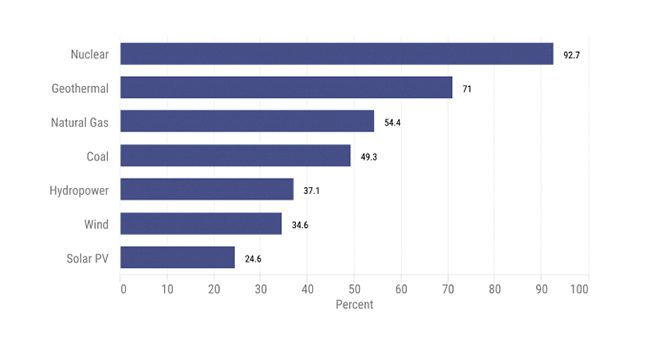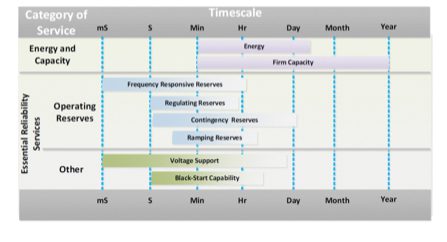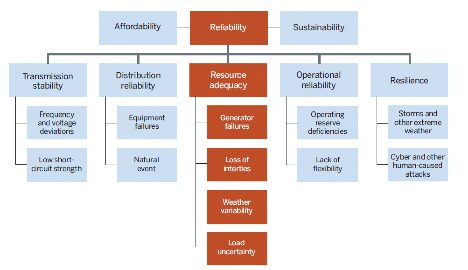Rethinking Energy Reliability with Modern Power Systems
As the energy transition to inverter-based resources continues, reliability risk increases and requires additional investment to mitigate threats. But what measures should be put in place, what are the associated costs, and how can the power generation industry budget accordingly?
The Federal Energy Regulatory Commission (FERC) recognizes that inverter-based resources (IBRs), in the form of utility-scale wind, solar, and battery resources connected to the bulk power system (BPS), have direct reliability impacts to the overall system. On Nov. 17, 2022, FERC issued two orders and published a Notice of Proposed Rulemaking related to concerns over reliability gaps associated with IBRs.
Meanwhile, the North American Electric Reliability Corp. (NERC) has investigated a series of “disturbances” that involve the widespread reduction (that is, loss of generation) of IBRs to identify systemic reliability issues. The “2022 Odessa Disturbance” report, a joint NERC and Texas RE staff report issued in December 2022, highlighted the significant risk to BPS reliability, issued immediate calls to action to enhance NERC standards for IBRs, and pushed NERC Reliability Standard enforcement.
To assure the effective and efficient reduction of risks to the reliability and security of the power grid, NERC develops and enforces Reliability Standards; annually assesses seasonal and long-term reliability; monitors the BPS through system awareness; and educates, trains, and certifies industry personnel. The NERC Reliability Standards define the reliability requirements for planning and operating the North American BPS. Those requirements apply to IBRs, and through the proposed rulemaking, will reach further downstream to increasingly smaller power generation facilities.
Energy Resilience and Reliability
Simply put, resilience for an electrical system is its ability to withstand adverse events without sustained interruptions of service to customers. Resilience is largely about what does not happen to the grid or electric consumers. Reliability, on the other hand, is a measure of behavior once resilience is broken. The start of a sustained interruption is the transition point from the domain of resilience to the domain of reliability.
The challenge of energy transition continues to be maintaining the correct mix of fuel-based generation with IBRs that will have both the capacity as well as the duration to meet load requirements throughout various demand scenarios. A few challenges associated with this transition process include the loss of system inertia or momentum, as large conventional prime movers such as turbine-driven generators are retired and removed from the grid, and a lack of reactive power, also known as volt ampere reactive (VAR) that is necessary for grid operations.
System inertia supports sudden changes in system frequency driven by fluctuations in electrical demand. Small deviations in both BPS voltage and frequency can potentially lead to significant system impacts. Inertia behaves a bit like the shock absorbers in a car’s suspension, which dampen the effect of a sudden bump in the road and keep the car stable and moving forward.
With regard to reactive power, alternating current power systems rely on magnetic fields to work. A transformer, motor, or generator cannot work without magnetic fields. The principle of operation of these devices is totally dependent on those magnetic fields. When reactive power drops, voltage drops, which can cause a circuit to fail.
All of these effects can be especially difficult for system operators to address during extreme weather events, and those impacts affect both system reliability as well as resilience. The Lawrence Berkeley National Laboratory published a paper suggesting that resilience has been a consideration within reliability for a long time. It credits three recent developments as drivers for the “unbundling” of reliability and resilience:
- ■ Our society’s reliance on high-quality, dependable electrical service has increased.
- ■ The U.S. has experienced several high-impact, low-frequency events (HILF events) with serious effects to the electric system.
- ■ New threats are emerging, such as cyberterrorism and the potential for geomagnetic disturbances, that could have devastating effects on the nation’s electric system.
These HILF events, also described as “Black Sky events,” are at the far end of the power generation spectrum (Figure 1)—a complete and lasting disruption in service.
 |
|
1. Reliability versus Black Sky events. Source: Lawrence Berkeley National Laboratory |
However, there is evidence that events historically categorized as low-frequency events are now also becoming more common. The Electric Power Research Institute (EPRI) found that:
- ■ Effective load-carrying capability calculations generally do not consider weather-correlated deviations from standard profiles for variable energy resource (VER) output that might result in large fleet-wide variations in the output of both existing resources and incremental units.
- ■ The availability and output of renewable sources being correlated with weather requires other resources and/or demand to rapidly respond to significant changes in renewable energy production.
- ■ It is acknowledged that natural gas–based generation is a critical supply technology needed to maintain reliable service to consumers; it is generally assumed to be an “available resource” even though both operational and regulatory issues can and do lead to that capacity being unavailable.
- ■ The industry’s methodologies for calculating resource adequacy assume that outages and reductions in output are independent and uncorrelated. Increased dependence on renewable technologies combined with a recognition of common mode events that affect multiple generators makes it clear that the assumption of independence may no longer be valid.
EPRI’s findings support the work now being undertaken by FERC. As the reliability-resilience continuum becomes more formalized, separate metrics and methodologies for reliability and resilience may become available. Those developments are needed and must include the Black Sky events mentioned above.
What Is Load Shedding and Why Is it Used?
Load shedding is, for all practical purposes, an organized power outage to protect the BPS—the “grid”—through reducing electrical demand by removing customers in an overall effort to protect the system from physical damage and protect it from complete system failure. Load shedding consists of two types of reductions in electrical load. Voluntary reductions in electrical demand for certain customers based on pre-scheduled or on-demand basis is commonly referred to as interruptible load. The other type of electrical load reduction is referred to as involuntary load shedding. This is when a utility electrical provider lowers or stops electricity distribution across the coverage area for a short period of time; this type of load shedding is commonly referred to as a rolling blackout.
When an involuntary load shed is ordered by the Regional Transmission Organization (RTO) or the Independent System Operator (ISO), it is done as a last resort to protect the BPS from a complete and catastrophic failure. Once the order is given, the various electrical transmission and distribution suppliers have a pre-determined list of circuits that have been identified as critical, that is, ones connected to hospitals, first responders, and other vital services, that are not included in the rolling blackout. These rolling blackouts generally exclude large transmission customers and other critical facilities directly associated with fuel supply.
System operators design procedures to disconnect load and apportion energy curtailment among customers as part of load shedding. Public utility commissions or boards are the regulatory authorities that approve the design of these systems. Ultimately, though, while technical considerations inform the decision-making process, load shedding is policy driven.
When determining the required power to be produced from a given system, capacity, the amount of generation that can be produced in full production, is a critical consideration. Capacity of a power plant is commonly described as nameplate generation capacity, which is the amount of power the manufacturer states the plant can produce. Other measurements of electrical capacity include net summer and net winter generating capacity.
The capacity factor can be thought of as how frequently a plant is running at its maximum power. The U.S. Energy Information Administration (EIA) provided capacity factors by energy source for 2021 as shown in Figure 2.
 |
|
2. U.S. capacity factor by energy source, 2021. Source: U.S. Energy Information Administration |
Grid Reliability and How to Define Acceptable Risk of System Failure
The main question when evaluating grid reliability is: What is an acceptable risk of system failure? When it comes to BPS reliability, how should reliability be defined, what is “acceptable,” and how is that revised standard achieved?
Designers, operators, and regulatory agencies each have internal assumptions based on their individual backgrounds in making these determinations. Location of the generating asset, historical information about weather, and other data points all figure into the analysis. As the inputs into the analysis are constantly evolving, there is a significant need to develop a dynamic system of analysis that considers the changing nature of generation, the location of generation, storage capability and capacity, and many other factors. Despite these lengthy events, reliability is generally evaluated in minutes or hours as reflected in the National Renewable Energy Laboratory graphic shown in Figure 3.
 |
|
3. Reliability is generally evaluated in minutes or hours. Source: National Renewable Energy Laboratory |
Resource adequacy and portfolio planning are becoming front-page issues in our decarbonizing society. A recent report by the Energy Systems Integration Group suggests moving beyond the current approach to resource adequacy/portfolio planning. According to that report, “rapidly increasing levels of wind, solar, storage, and load flexibility require the industry to rethink reliability planning and resource adequacy methods for modern power systems. Periods with a risk of shortfall often no longer coincide with peak demand—reliability risks are less about peak load and more about the daily setting of the sun, extended cloud cover, wind speeds, cold snaps, and heat waves.”
Updating Considerations for Grid Planning with Modern Power Systems
Consequently, as resource adequacy and planning procedures continue to evolve amid decarbonization, it will still be paramount to maintain the three pillars of power system planning: affordability, sustainability, and reliability. Today, affordability is part of the evolving decarbonization discussion and still includes the traditional inputs, but now must also account for a variety of newly injected factors, some caused by IBRs, to determine the ultimate cost to the consumer.
NERC defines reliability for the grid as:
- ■ Adequacy, or the ability of the electric system to supply the aggregate electrical demand and energy requirements to the end-use customers at all times, taking into account scheduled and reasonably expected unscheduled outages of system elements.
- ■ Operating reliability (formerly titled Security), or the ability of the electric system to withstand sudden disturbances such as electric short circuits or unanticipated loss of system components.
Because of the issues discussed here, NERC and FERC are actively working to address reliability and resilience. Through its Reliability Issues Steering Committee, NERC has developed a Resilience Framework focused on robustness, resourcefulness, rapid recovery, and adaptability (Figure 4).
 |
|
4. The North American Electric Reliability Corporation’s (NERC’s) Resilience Framework. Source: NERC |
The risk of shortage of generation can be offset by increasing the investment in generation, that is, adding more megawatts (MWs). However, the increased investment translates to increased cost to the consumer or simply affordability.
The acceptability of a reliance metric depends not on the day-to-day demands of the system but rather on the system’s ability to maintain connectivity throughout an extreme event such as the multi-day events referenced above. An important aspect of system reliability (Figure 5), in addition to operating throughout an extreme event, is the ability to rebound from that event, and this is generally referred to as resilience of the system.
 |
|
5. Elements of grid reliability. Source: Energy Systems Integration Group |
An acceptable reliability outcome for the BPS is the ability to bend but not break—resilience is the capability of the system to return to normal operations. What became evident from Winter Storm Uri was that the impact of system performance in terms of temperature was significantly magnified by the duration of the event.
What Needs to Change to Improve Energy Reliability and Resilience?
So, how do these issues factor into actual reliability performance at the BPS level and how is that reliability correctly valued? Why would the current state of technology and understanding of electrical system behavior allow for a 20,000 MW load shed—one of the largest (if not the largest) in U.S. history—that lasted for days on end? How could it occur in a state like Texas, which leads the nation in total installed electrical generation capacity, and leave more than 4.5 million people without essential electrical service during an extreme weather event?
The answer may lie in how system reliability risk is established and what is determined as acceptable. Regardless of how ISOs and RTOs have historically defined acceptable risk, an actual event determines for us the current metric. For Texas, a week of sub-freezing temperatures inducing a multiple-day load shed reaching a peak of 20,000 MW is the de facto current risk level for reliability. But is that still acceptable? Also, what has changed and why has it changed?
Much has been learned from Winter Storm Uri and similar force majeure events. We learned that the BPS reliability risks include a constellation of considerations including unanticipated impacts on fuel availability, the appropriateness of the reliability timescale, and fuel diversity, among many other variables. As we saw with the effects on natural gas production, the impacts related to fuel availability for the local grid were multiplied. Today, we need a dynamic planning approach that changes to reflect the ever-changing inputs to the reliability matrix.
Finally, how does the energy transition’s potential impact on reliability affect those services that manage risks associated with the aftermath of a storm? Qualitatively, those impacts are significant and need to be part of the assessment on reliability. How we define acceptable risk when it comes to grid reliability needs to transition at the same pace as the systems themselves, and it will require a review of both the metrics and how those metric results are priced in the market.
—John F. Peiserich is a senior vice president in J.S. Held’s Environmental, Health & Safety – Risk & Compliance group; John Dulude, PE is a senior vice president at J.S. Held and leads the Energy Transition & Impact Assessment and Permitting service line within its Environmental, Health & Safety Practice; Edo Macan is an executive vice president in J.S. Held’s Energy Economics group; and Chris Norris is a vice president at J.S. Held working in Energy Transition – Special Projects within its Technical Services Division and Environmental, Health & Safety Practice.